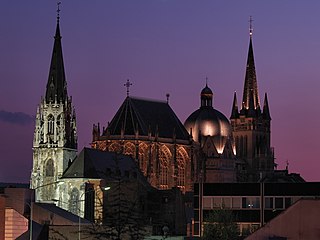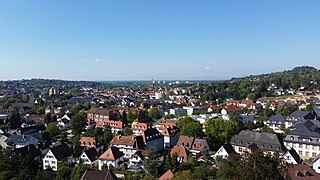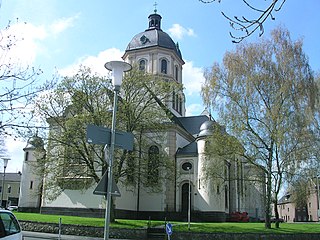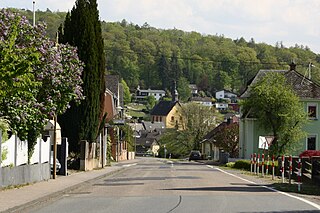
Aachen is the 13th-largest city in North Rhine-Westphalia and the 27th-largest city of Germany, with around 249,000 inhabitants.

Neuwied is a town in the north of the German state of Rhineland-Palatinate, capital of the District of Neuwied. Neuwied lies on the east bank of the Rhine, 12 km northwest of Koblenz, on the railway from Frankfurt am Main to Cologne. The town has 13 suburban administrative districts: Heimbach-Weis, Gladbach, Engers, Oberbieber, Niederbieber, Torney, Segendorf, Altwied, Block, Irlich, Feldkirchen, Heddesdorf and Rodenbach. The largest is Heimbach-Weis, with approximately 8000 inhabitants.
Ahrweiler is a district in the north of Rhineland-Palatinate, Germany. It is bounded by the districts of Euskirchen, Rhein-Sieg and the city of Bonn in the state of North Rhine-Westphalia, and the districts of Neuwied, Mayen-Koblenz and Vulkaneifel.

Neuss is a city in North Rhine-Westphalia, Germany. It is located on the west bank of the Rhine opposite Düsseldorf. Neuss is the largest city within the Rhein-Kreis Neuss district. It is primarily known for its historic Roman sites, as well as the annual Neusser Bürger-Schützenfest. Neuss and Trier share the title of "Germany's oldest city"; and in 1984 Neuss celebrated the 2000th anniversary of its founding in 16 BCE.

Jülich is a town in the district of Düren, in the federal state of North Rhine-Westphalia, Germany. As a border region between the competing powers in the Lower Rhine and Meuse areas, the town and the Duchy of Jülich played a historic role from the Middle Ages up to the 17th century.

Lahr ; Low Alemannic: Lohr) is a town in western Baden-Württemberg, Germany, approximately 50 km north of Freiburg im Breisgau, 40 km southeast of Strasbourg, and 95 km southwest of Karlsruhe. It is the second largest city in Ortenau (district) after Offenburg, and serves as an intermediate economic centre for the cities and towns of Ettenheim, Friesenheim, Kappel-Grafenhausen, Kippenheim, Mahlberg, Meißenheim, Ringsheim, Rust, Schuttertal, Schwanau and Seelbach.

The Rhine Province, also known as Rhenish Prussia or synonymous with the Rhineland, was the westernmost province of the Kingdom of Prussia and the Free State of Prussia, within the German Reich, from 1822 to 1946. It was created from the provinces of the Lower Rhine and Jülich-Cleves-Berg. Its capital was Koblenz and in 1939 it had 8 million inhabitants. The Province of Hohenzollern was militarily associated with the Oberpräsident of the Rhine Province. Also, for a short period of time, the Province of Hohenzollern was indirectly and de-facto controlled by the Rhine Province.

Ettlingen is a town in Baden-Württemberg, Germany, about 8 kilometres (5 mi) south of the city of Karlsruhe and approximately 15 kilometres (9 mi) from the border with Lauterbourg, in France's Bas-Rhin department. Ettlingen is the second largest town in the district of Karlsruhe, after Bruchsal.

Würselen is a town in the borough of Aachen, in North Rhine-Westphalia, Germany.

Rheinau is a town in southwestern Baden-Württemberg, Germany and is part of the district of Ortenau.

Marl is a town and a municipality in the district of Recklinghausen, in North Rhine-Westphalia, Germany. It is situated near the Wesel-Datteln Canal, approx. 10 km north-west of Recklinghausen. It has about 90,000 people.

Blieskastel is a city in the Saarpfalz (Saar-Palatinate) district, in Saarland, Germany which is divided into villages. It is situated on the river Blies, approximately 10 kilometres southwest of Homburg (Saar), 8 km (5 mi) west of Zweibrücken, and 20 km (12 mi) east of Saarbrücken.

The Diocese of Aachen is one of 27 dioceses in Germany and one of the six dioceses in the ecclesiastical province of Cologne. The incumbent bishop is Helmut Dieser, who was appointed by Pope Francis on 23 September 2016. The bishop's seat is Aachen.

Hillscheid is an Ortsgemeinde – a community belonging to a Verbandsgemeinde – in the Westerwaldkreis in Rhineland-Palatinate, Germany.

Soers is a community within Aachen and part of the district of Aachen-Laurensberg. The predominantly rural district today stretches from the border of Aachen-Mitte, the central district of Aachen, past the slopes of the Lousberg, a hill in the north of the city. It is a wetland that is drained by several rivers. The Wurm drains at out of the area's north end, and is the only drain of the Rur River in the Aachen Basin. Soers is known mainly as a result of the Old Tivoli, the former football stadium of Alemannia Aachen.
Richterich is a borough and northwestern suburb of Aachen, Germany. The towns of Horbach and Huf belong to the borough, which borders the other Aachen borough of Laurensberg, as well as the Kohlscheid borough of Herzogenrath. It is assumed that the histories of Richerich and Horbach go back a long time, since the name is suggestive of a Celtic settlement. In Roman times, the attested name of the area was recteriacum.
Brand is a borough of Aachen, Germany, with about 18,000 residents. The borough lies in the south-east part of Aachen and borders Kornelimünster/Walheim, Forst, Oberforstbach und Eilendorf, as well as the town of Stolberg.
Eilendorf is a borough of Aachen, Germany, that has around 15000 inhabitants. The communities of Eilendorf and Nirm share a border with the other Aachen boroughs of Brand, Aachen-Mitte, and Haaren, as well as Atsch in Stolberg.
Kornelimünster/Walheim is the southernmost Stadtbezirk (borough) of Aachen, Germany, and borders the Eifel area of North Rhine-Westphalia, as well as Belgium. It became part of Aachen in 1972, after all of the communities surrounding the city were reorganized administratively. The countryside is called Münsterländchen.

Kornelimünster is a town in the rural Münsterländchen area of Kornelimünster/Walheim, a district of Aachen, Germany.





















